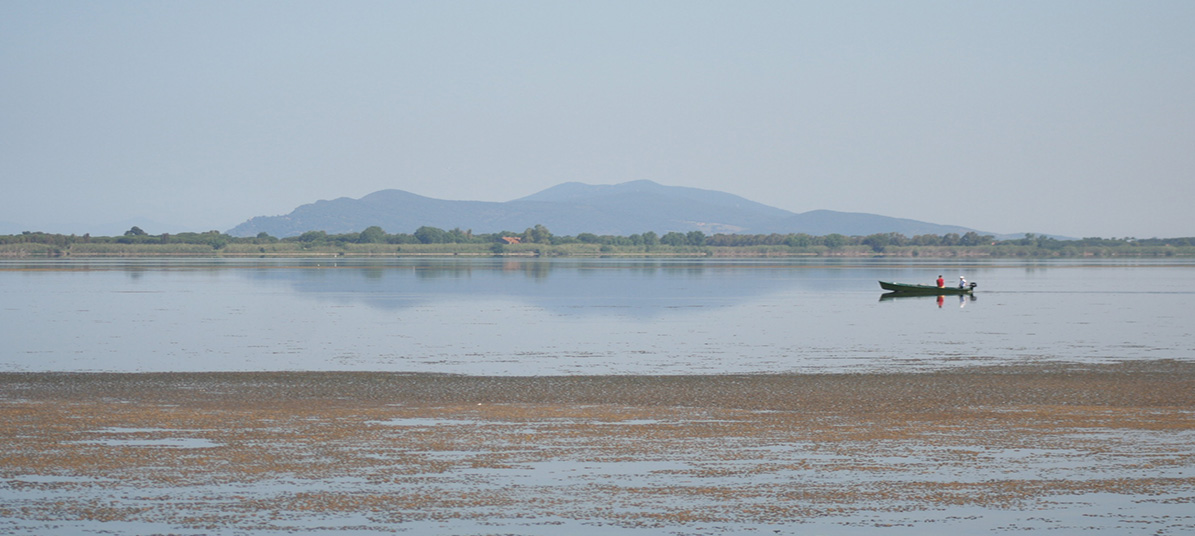| |

|
 |

|
 
 |
|
Bordering the Lazio region, the "Maremma" is one of the most beautiful areas in Tuscany. There are a number of charming beaches along the Maremma coastline: one, a long sandy stretch from Castiglione della Pescaia to Marina di Grossetto, can be virtually deserted in the middle of August. A short way south of Marina di Grosseto, the Marina di Alberese beach, at the end of a long track which virtually drops you in the Mediterranean, is busier but good for families, and has shade in an extensive area of woodland behind the beach – also a fun place to mountain bike.
The Maremma seashore, overlooking the Tirrenian Sea, features some of the most beautiful sand beaches of Tuscany.They stretch from Principina a Mare and Marina di Grosseto through Castiglione della Pescaia to Punta Ala and the blue sweep of the Gulf of Follonica, and afterwards along the spectacular etruscan coast, the Costa degli Etruschi up to Piombino.
In the south they spread from the Ombrone delta into the wildest tiny gulfs within the Regional Park of Maremma.
Some of these beaches are quite isolated and wonderful, from a natural viewpoint. They are very often embellished by sand dunes, behind which evergreen bushes lead the way to a flourishing and thick pine forest. This type of wood is very closely tied to the history of this land with its past of drainages.
The area around Grosseto and the coast, with Marina di Grosseto, Castiglione della Pescaia and the small villages that lie in the plain between the city and the coast, represents the heart of the Tuscan Maremma.
Maremma includes 160 km of shoreline. The stretches of sandy and rocky coastline allow all sea lovers to find the perfect place for them. Moreover, the vast pine tree forests which border the beaches of the Maremma are a real naturalistic treasure and so are the few areas where the lagoon and swamp ecosystems have survived urbanization, reclamation or simple draining, such as the nature reserve of the Diaccia Botrona near Castiglione della Pescaia, and the Parco Naturale della Maremma between Alberese and Talamone.
Grosseto can be considered the capital of the Maremma. The area around Grosseto and the coast, with Marina di Grosseto, Castiglione della Pescaia and the small villages that lie in the plain between the city and the coast, represents the heart of the Tuscan Maremma.
|
| |
|
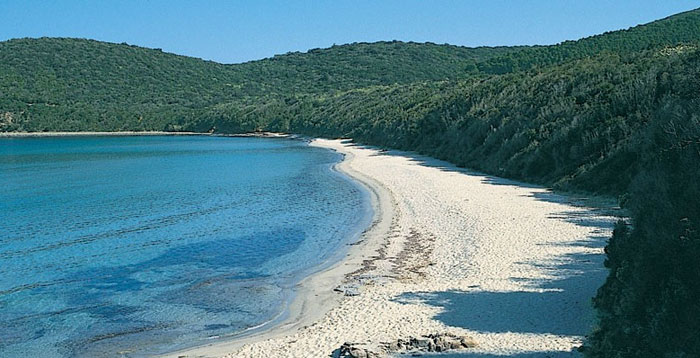 |
| |
|
|
|
Cala Violina
|
| |
|
The beach's name derives from its very rare characteristic (it appears there is only one another beach with such a peculiarity) by which, steeping on the sand, the latter will echo back the harmonious notes of a violin.
|
|
| |
|
|
| Principina a Mare |
|
Principina a Mare is a place mainly bathing fraction of the town of Grosseto. Principina a Mare is quite popular thanks to its proximity to the mouth of the River Ombrone and the Natural Park of Maremma.
Marina di Grosseto is a frazione of Grosseto. It houses a fort, known as Forte di San Rocco, built by the Grand Dukes of Tuscany in the 18th century.
There are a number of charming beaches along the Maremma coastline: one, a long sandy stretch from Castiglione della Pescaia to Marina di Grossetto, can be virtually deserted in the middle of August. |
|
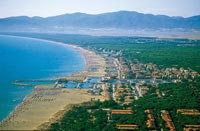
Marina di Grosseto
|
| Diaccia Botrona |
|
The Diaccia Botrona Marshland is the last relic of a once large Etruscan and Roman lake - lago Prile - that lay between Grosseto and Castiglione della Pescaia. Long coastal dunes, the tombolo separate the marshland from the Tyrrhenian Sea.
The Nature Reserve of Diaccia Botrona is of great environmental importance, both for the variety of plant species, both for the role it plays in supporting the migration and wintering birds. Represent what remains of a wider area marshy, affected by an artificial water system, carried out at different times, for the remediation of a good part of the plain between Castiglione and Grosseto.
|
|
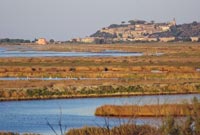
The Nature Reserve of Diaccia Botrona
|
| Castiglione della Pescaia |
|
Castiglione della Pescaia, is located in the South-Western portion of Tuscany, with a gorgeous view of the islands of Elba and Giglio, and of the promontory of Argentario. The hills that back the city slope into beautiful beaches that front the town in its entirety.
Castiglione della Pescaia, a delightful village of Roman origin, has developed on the summit of Mount Petriccio within mighty walls with 11 towers and 3 portals and the Castle XV, that keep intact their charm, such as small streets of stone, the ancient portals and arches that susseguono.
The modern city grew around a medieval fortress and a large fishery, from which it got its designation. Castiglione consists of a High City built on the hill that ends a chain of hills towards the sea, and of a Low City at the foot of the High City, straddling the drainage canal and marina that form the central part of town.
Castiglione della Pescaia is a famous and popular seaside resort town known for its sandy beaches and Tombolo pine forest.
|
|
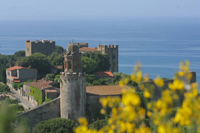
Castiglione della Pescaia |
Rochette
Punta Ala |
|
Rocchette is a small seaside resort that takes its name from the rocky peninsula where a beautifully preserved 11th century castle stands. This fortified castle, set on a dramatic cliff-top, 100 metres above the sea, was build to defend the Etruscan coast from the raids of the Moors. The castle is now hunting lodge and summer residence of the Marchesi Lucifero. The hill of Le Rocchette is extremely fascinating because it has remained unspoilt surrounded as it is by scrub and pine trees.
The beaches of Roccamare and Le Rocchette merge into one another along the coast between Castiglione della Pescaia and Punta Ala.
On top of the promontory of Le Rocchette sits the Forte delle Rocchette, once a look-out tower and now a private residence with uninterrupted views across the Mar Tirreno, Tyrrhenian Sea.
Punta Ala, a modern and well equipped residential village with a rational tourist port, rises on a promontory surrounded by the sea in a wonderful position.
One o the main attractions is Golf Club Punta Ala. Another attraction in the area is Abbazia di San Pancrazio al Fango. |
|
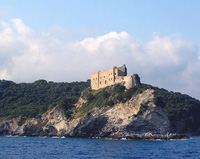
Forte delle Rocchette |
| |
|
|
|
|
| Gavorrano |
|
The medieval center of Gavorrano rises on the side of Mount Calvo in the heart of the Grosseto Maremma with a splendid view of sea and hills.
Gavorrano was founded in the 11th century as a possession of the Bishop of Roselle. Main sights are remains of Castel di Pietra ("Stone Castle"), built by the Count Nello of Pannocchieschi. This castle passed to the legend because it was the place where Pia of Tolomei, Nello's second wife, was murdered by her husband. She died in the Castello di Pietra. The great Italian poet Dante Alighieri remembered that event in his Divine Comedy (Purgatory V: “Siena mi fè, disfecimi Maremma ” “Siena gave me life, Maremma took it away”).
|
|
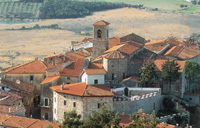
Gavorrano
|
| Scarlino |
|
Situated amongst a panorama of immense beauty and great environmental interest, Scarlino, small but definitely extraordinary, rises on one of the slopes of the Monte Alma, and is seen as a small jewel of art and culture.
Scarlino Castle in the Grosseto region of Tuscany acted as a stronghold against enemies and pirates landing at nearby cities.
Scarlino encloses in its territory the area of the Bandite di Scarlino, a protected ANPIL area (Protected Natural Area of Local interest). The area includes hills and coast, over 750 hectares.
in the Bandite di Scarlino reserve, which is divided by a small promontory from Punta Ala, among a multitude of small caves, you will find Cala Violina, a sandy bay of great beauty. Cala Violina has been rewarded from Legambiente like one of the 11 most beautiful beaches of Italy. |
|
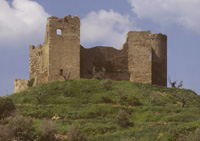 Scarlino, castello
|
| Cala Violina |
|
Inside the Follonica Gulf, in the Bandite di Scarlino reserve, which is divided by a small promontory from Punta Ala, among a multitude of small caves, you will find Cala Violina. The beach's name derives from its very rare characteristic (it appears there is only one another beach with such a peculiarity) by which, steeping on the sand, the latter will echo back the harmonious notes of a violin.
Cala Violina has been rewarded from Legambiente as one of the 11 most beautiful beaches of Italy.
La Riserva Naturale delle Bandite di Scarlino has an adequate and efficient net of signed paths for trekking and mountain bike. The most beautiful path of the area is without a doubt that of the Costiere whose access is possible only on foot, on horse or in bicycle, it pass through beautiful rocky coves of certain beauty, like Cala Francese, Cala Martina, and Cala Violina.
Cala Violina attracts in every period of the year, but in the summer, an exorbitant number of tourists overrun the beach, and you are baffled by the number of boats that are anchored beyond the floaters delimitating the beach.
Cala Violina is only accessible by foot, bike or horse. There are several possibilities to reach Cala Violina. The beach can be is reached by the route to Cala Martina [1] or by a dirt road indicated 400 meters before the gas station beyond Portiglione on the road to Castigione della Pescaia [2] (between Marina di Scarlino and Pian d'Alma).
Walking in Tuscany | A walk close to the sea, towards Cala Violina and Cala Martina |
|
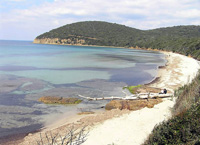
Cala Violina
|
| |
|
|
|
|
| Torre Mozza |
|
The village of Torre Mozza belongs to the municipality of Piombino. Torre Mozza beach takes its name from the medieval tower that sits on the waters edge. It is situated within a natural park, the Parco Costiero Della Sterpaia, a short distance from either Follonica or Riotorto. Torre Mozza beach is a public beach with a great wide stretch of sand and a great view of the whole of the Gulf sweeping from the ancient port of Piombino, past Torre di Sale, Torre Mozza, the seaside resort town of Follonica, the white tower of Torre Civette, and lastly to the promontory and southern-most point of the Gulf at the millionaire sailing port of Punta Ala. |
|
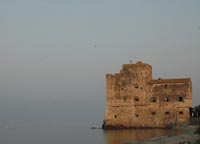
Torre Mozza
|
| Piombino |
|
Piombino, a modern and active town, has always been an important strategic place thanks to its particular geographic position which allowed both the control of the Tuscan Sea and the access to the peninsula. Piombino is situated on a promontory jutting out into the sea. It was the capital of an ancient Italian state and is heir to classical and medieval, as well as Etruscan metalworking traditions.
Island of Elba
Car ferries leave Piombino almost hourly for Portoferraio in the summer season. There are also daily ferries for Cavo and Rio Marina.
The main shipping companies are Toremar, Blu Navy, Moby Lines and Corsica Ferries. |
|
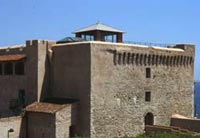
Piombino Castle
|
| |
|
|
|
|
| |
|
View Larger Map |
|
|
|
|
|
| |
|
Southern Tuscany and Lazio | From Principina a Mare to Ansedonia
|
|
|
| Grosseto |
|
Grosseto lies on the Tuscan coast of the area known as the Maremma, a large and diverse area covering parts of southwestern Tuscany and some of northern Latium. The Alta Maremma is the northern part, from Grosseto northwards to Cecina River just south of Livorno.
The city has a lovely old town center enclosed by its marvelous Hexagonal Walls. They were built by the Medici at the end of the 16th century. Main sights of Grosseto are the Medicean Walls, the Duomo, Palazzo Aldobrandeschi, the Museo Archeologico e d'Arte della Maremma and Roselle Archeological Area.
Market on Thursday.
The main attraction nearby is Castiglione della Pescaia, also known as Terrazzo o Balcone della Maremma, a very attractive town consisting of a fishing boat harbour dominated by a mediaeval castle.
Other sight of interest are the ruins of the Abbey of San Pancrazio al Fango, between Grosseto and Castiglione della Pescaia, in the Natural Reserve of the Diaccia Batrona, and the Abbey of San Rabano, also in ruins, located in the Parco Nazionale della Maremma.
|
|
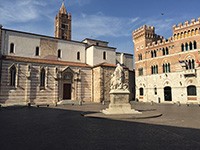
Grosseto
|
| Alberese |
|
The Maremma Park, with its range of hills descending towards the sea to reach the sandy beaches and cliffs, spreads from the mouth of the Ombrone river till it reaches Talamone, along 25 km of the breathtaking Tuscan coastline surrounded by marshland, pinewood forests, tilled land and pastures.
The Maremma Park extends over a rectangular area of 17.000 hectares, bounded on the north by the Tombolo pine forest and Talamone in the south.
The Maremma Regional Park is opened all year round, every day. It is necessary to purchase a ticket in one of the visitor centers in Alberese or Talamone.
The Park has 7 itineraries in the inner side and 3 itineraries through the coast line.
Walking in Tuscany | | From Alberese to San Rabano and from Alberese to Cala di Forno, itineraries between sea and mountains
|
|

Marina di Albarese
|
| Talamone |
|
Talamone stands on a little promontory, dominated by an ancient Sienese fortress, to the extreme south of the Monti dell'Uccellina. In antiquity Talamone was an Etruscan port.
At the top of the rocky hill you can see a wonderful view, following the coast line of Osa, you see right up until the promontory of Argentario,with its jagged coast, its coves with crystal clear sea. |
|
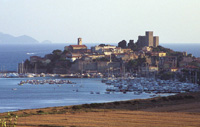
Talamone |
| |
|
|
|
|
| Orbetello |
|
The peninsula Monte Argentario is connected with the mainland by three dams which form two lagoons, the Laguna di Ponente on the west side and the Laguna di Levante on the east side of the middle dam. Orbetello is located on the middle dam between the two lagoons.
The lagoon is separated from the sea by two strips of land. To the North-West the Gianella about 7 km long with a road, pine trees and camping's. To the South the Feniglia a 6 Km long pine wood with beach. The Feniglia is a natural reserve, only pedestrians and bicycles are allowed.
In the middle of the lagoon is an isthmus on with the town of Orbetello was build. Part of the Laguna di Ponente (West) is under protection of the WWF.
The Molino Spagnolo or Spanish mill is the only wind mill which remained from a series of nine built by the Sienesi and subsequently restored by the Spaniards, when the lagoon city became the capital of the small State of the Presìdi - State of Royal Spanish Garrisons (1557).
|
|
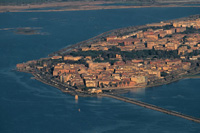
Orbetello
|
| |
|
Not to be missed are the characteristic and famous beaches like Feniglia, Giannella and Ansedonia with its golden sand continuing with Torba and Marina di Capalbio with its dark, almost black sand.
The Feniglia dune, for its entire length and breadth, 6 km by 1 km, is entirely covered by pine-woods.
|
|
|
| |
|
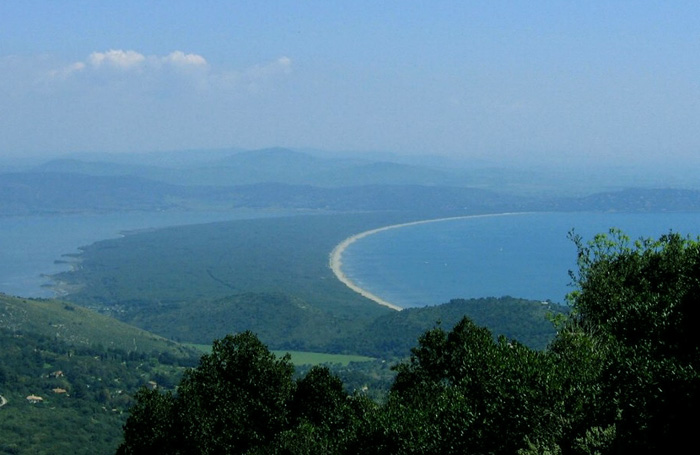 |
| |
|
Tombolo di Feniglia, view from Monte Argentario
|
| |
|
|
|
|
| Monte Argentario |
|
Monte Argentario is one of the most famous spots in the Maremma and Tuscany. The promontory, which was originally an island, is characterized by a high, rocky coastline covered by a thick Mediterranean thatch, interrupted by olive groves and vineyards. It is now connected to the land by the Feniglia and Giannella sand bars, two strips of uninterrupted sandy beach and thick maritime pine. The sandy isthmuses are separated by the Laguna di Orbetello, an area protected by the WWF because it sits on one of the most important migratory routes and is one of the principal wintering sites for birds that nest in Europe. |
|

Monte Argentario
|
| Porto Santo Stefano |
|
Porto Santo Stefano is the largest town on Mount Argentario, and connections leave from here for the islands of Giglio and Giannutri. Porto Santo Stefano is a famous resort with two ports, Porto Nuovo and Porto Vecchio.
Porto Ercole is located on the eastern coast of the Argentario. It is a charming seaside village that overlooks a bay protected by a small promontory. |
|
 Porto Santo Stefano
Porto Santo Stefano |
| |
|
|
|
|
| Ansedonia |
|
Directly across the harbor from Porto Ercole lies Ansedonia, an almost sleepy little town with some of the best beach front in Tuscany. Ansedonia flourished in the 60's, with well-known architects of the time designing villas for the rich and famous, mostly in the mass-media circuit. Now, it is seen more as a retro relic of the past society.
Extending parallel to the coast, Lake Burano and the immediately surrounding district make up one of the most important wetland habitats in Italy in terms of the integrity of the environment and accommodation and teaching facilities. Lago di Burano is a typical Mediterranean coastal lagoon behind a line of sand dunes. A beautiful Spanish watch-tower with a square plan, Torre di Biranaccio, completes the atmospheric panorama of the lake.
|
|
|
| |
|
|
|
|
Capalbio |
|
Capalbio has a medieval town plan, with narrow, curved streets climbing to the top of the hill dominated by the Rocca Aldobrandesca.The town is compietely enclosed within a double set of Sienese walls, along which extensive stretches of the suggestive patrol bays can still be walked.
Situated in the tiny Italian village of Pescia Fiorentina, east of Capalbio, is the Garden of the Tarot Cards, an original creation by the French artist Niki De Saint Phalle. The garden is half a dozen miles from the beach resort of Capalbio.
From the summit of the hill beautiful views of Capalbio beach and the Burano lagoon can be seen. From Capalbio the road travels deep into the hills of the Maremma to the land of the Etruscans and the ancient cities made in Tufo.
The road continuing along the coast past Capalbio Scalo reaches the Lake of Burano and the Lake of Burano Nature Preserve.
Il Giardino dei Tarocchi or The Garden of Tarot is a sculpture garden based on the esoteric tarot created by Niki de Saint Phalle in Pescia Fiorentina, località Garavicchio.
The Tarot Garden was a sanctuary of imagination and dreams to Niki de Saint Phalle (1930-2002).
"In 1955 I went to Barcelona. There I saw the beautiful Park Güell of Gaudi. I met both master and my destiny. I trembled all over. I knew that I was meant one day to build my own Garden of Joy."
|
|
|
Tuscania
|
|
Leaving the coast, the road travels deep into the hills of the Maremma to the Area del Tufo, one of the most important Etruscan centres.
Tuscania is one of the loveliest towns in Upper Lazio. Built on a hilltop by the Etruscans in the 7th century BC, the town was situated in the river Marta valley, about 10 miles from Viterbo.
Vulci, Tarquinia and Tuscania represent the emblems of Etruscan civilization. The ancient city Tuscania was a prosperous Etruscan centre in the 3rd century bc, and Etruscan tombs have been found nearby. In the Medieval historical center the beautiful Roman basilica of San Pietro stands on the old Etruscan acropolis, and has a 13th century façade with symbols of the Evangelists. The basilica, one of the most magnificent monuments in the Viterbo area, probably dates to the eighth century. The interior has massive 11th century columns with beautiful capitals and decorative pavings.
At the foot of the hill stands the church of Santa Maria Maggiore, built during the same period as the church of San Pietro. |
|
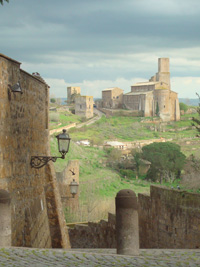
Tuscania
|
Vulci
Lago Pellicone |
|
Vulci was the centre of a large city-state, but after the 6th century it had to relinquish parts of this territory to Rome.
In the Castello della Badia you will find the Museo Archeologico Nazionale di Vulci. There are a number of important Etrusco-Roman remains on the site of the ancient city.
In the Natural Park of Vulci we can walk along the paths following the course of the Fiora, along the ancient roads that led from Vulci and Castro to the sea.
Walking in Tuscany | Vulci and Castello della Badia |
|
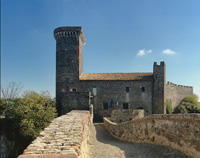
Vulci | Castello della Badia
|
| Tarquinia |
|
Tarquinia, a medieval town famous for its archeological remains, is situated just a few kilometres from Tuscany, in Northern Lazio, very close to Capalbio and Monte Argentario and less than 1,5 hour drive from Podere Santa Pia.
Tarquinia is custodian of an incredible number of treasures, including very old constructions, ancient palazzi and historic churches, all of which serve as an extraordinary testimony to the past of this town.
Tarquiniais the Etruscan town per excellence. The frescoed walls of its tombs, famed throughout the world, are covered with the most archaic painting of the italic civilisation. The necropolis of Tarquinia contains 6000 tombs, 60 of which include wall paintings.
The main site is the Necropolis of Monterozzi, with a large number of tumulus tombs with chambers carved in the rock. The scenes painted include erotical and magic depictions, landscapes, dances and music. There are also carved sarcophagi, some dating to the Hellenistic period. Main tombs included the Tomba della Fustigazione and the Tomb of the Leopards.
Tarquinia Etruscan Museum, housed in Palazzo Vitelleschi, is very likely the most important Etruscan Museum in the world.
Tarquinia | The Necropolises of Tarquinia and Cerveteri
|
|

Tarquinia, Santa Maria in Castello
|
| |
|
|
|
|
| |
|
View The Maremma seashore [2] From Principina a Mare to Ansedonia in a larger map |
| |
|
|
| |
|
|
|
|
|
|
|
|
|
|
| |
|

Maremma Regional Park official website: www.parco-maremma.it | Alberese Visitor Center: Address: Via del Bersagliere, 7/9 - Alberese (GR) | Visitor Center and Talamone Aquarium - Address: Via Nizza, 12 - Talamone (GR)
The most beautiful beaches of Tuscany | [1] From Principina a Mare and Castiglione della Pescaia to Cala Violina and Piombino
The most beautiful beaches of Tuscany | [2] From Principina a Mare to Ansedonia
|
| |
|

|
|
| |
|
 |
|
| |
|
 |
|
| |
|
 |
|
| |
|
 |
|
| |
|
 |
| |
|

|
| |
|
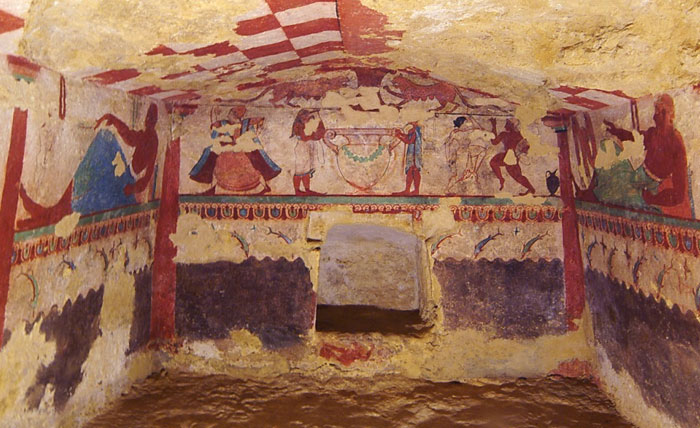 |
| |
|
Tarquinia, Tomba delle Leonesse (The Tomb of the Lioness)
|
| |
|

 |
| |
|
|
|
|
|
|
|
|
|
|
|
